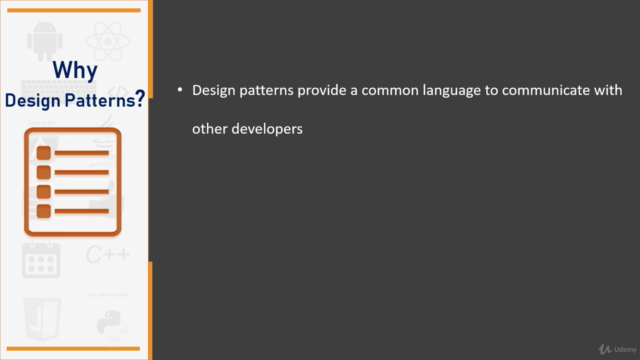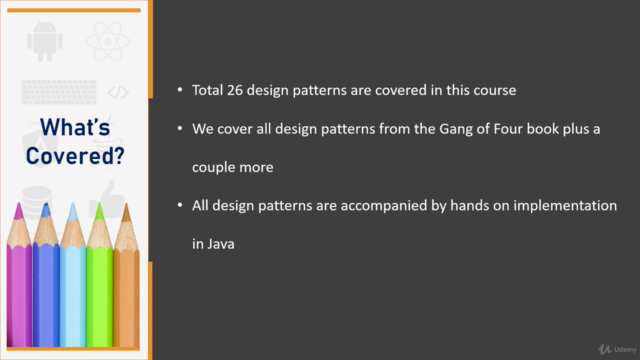Java Design Patterns & SOLID Design Principles

Why take this course?
🎓 Course Overview:
This comprehensive course is dedicated to mastering the SOLID Design Principles and exploring 26 design patterns, spanning Creational, Structural, and Behavioral categories. The course is structured for both beginners and experienced developers, as well as software designers and architects who aim to enhance their understanding of design principles and patterns.
SOLID Design Principles:
- Single Responsibility Principle (SRP)
- Open-Closed Principle (OCP)
- Liskov Substitution Principle (LSP)
- Interface Segregation Principle (ISP)
- Dependency Inversion Principle (DIP)
Creational Design Patterns:
- Simple Factory
- Abstract Factory
- Factory Method
- Singleton
- Builder
- Prototype
- Object Pool
Structural Design Patterns:
- Object Adapter
- Class Adapter
- Decorator
- Bridge
- Facade
- Static Proxy
- Dynamic Proxy
- Flyweight
- Composite
Behavioral Design Patterns:
- Chain of Responsibility
- Command
- Interpreter
- Mediator
- Iterator
- Memento
- Observer
- State
- Strategy
- Template Method
- Visitor
- Null Object
Course Structure:
The course focuses on live coding with theoretical explanations, followed by UML and slides for a comprehensive understanding. Each design pattern is covered in depth with separate lectures:
- Introduction - An overview of the design pattern, problem it solves, and a formal UML diagram.
- Implementation Steps - Guidance on implementing the pattern in Java.
- Example UML - The UML diagram for the implementation problem we're addressing.
- Implementation - A live coding session to implement the design pattern in Java using Eclipse IDE.
- Implementation & Design Considerations - Insights on performance, design variations, and practical advice on using the pattern.
- Real World Example - Examples of how the pattern is used in real-life Java applications or frameworks like Spring or JSF.
- Comparison with Similar Pattern - Understanding the differences between this pattern and similar ones.
- Pitfalls - Discussion on common mistakes and issues associated with the design pattern.
- Summary - A concise summary of all aspects of the design pattern.
What You'll Get:
- Complete code samples from hands-on lectures to follow along or study later.
- PDF slides and UML diagrams for each design pattern, offering a quick reference for the structure and roles.
- A comprehensive PDF guide with all design pattern summaries, code samples, and UML diagrams.
Who Should Take This Course?
This course is suitable for:
- Beginner developers who want to start learning about design patterns and principles.
- Experienced developers looking to deepen their understanding or fill gaps in their knowledge.
- Software designers and architects aiming to incorporate best practices into their projects.
By the end of this course, you'll have a solid foundation in both the theoretical and practical aspects of design patterns, equipping you with the skills to apply these principles effectively in your own software development endeavors.
Course Gallery




Loading charts...
Comidoc Review
Our Verdict
This master guide on Java Design Patterns and SOLID principles offers a comprehensive look at 26 design patterns, particularly resonating with senior Java developers working in enterprise environments. Although thorough, the excessive course length and some unrelated comparisons can be confusing or tiresome. The instructor's vast experience is evident from carefully curated real-world examples that make up for minor flaws such as low audio quality and the absence of an official code repository.
What We Liked
- Comprehensive coverage of 26 design patterns, including Gang of Four & SOLID principles with real-world examples in Java
- In-depth explanations and practical examples that resonate with experienced developers working on enterprise Java EE applications
- Well-crafted slides and engaging presentations supplemented by comparisons between patterns with clear, concise summaries
Potential Drawbacks
- Long durations and repetitive content make it tiresome to watch every design pattern video from start to finish
- Instructor sometimes compares unrelated design patterns which might confuse learners
- Code examples are provided as ZIP files only, without an accompanying GitHub repository or multiple examples per pattern